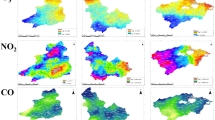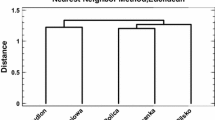Abstract
Interspecific comparison in metals and PAHs profile in three lichen species, Flavoparmelia caperata, Phaeophyscia hispidula and Pyxine sorediata, were studied in different altitudinal gradients of the Western Himalayas. The species collected from 14 sites, enroute from Dehradun to Morinda (243 Km) including the trekking route 42 Km from Taluka to Morinda having an altitudinal gradient between 850–3,750 m, were analysed for their metals and PAHs. The species showed similar metal as well as PAHs profile under similar altitudinal gradients in the sequence of F. caperata > P. hispidula > P. sorediata. The difference in pollutant concentrations within each lichen species may be related to intrinsic attributes of the species, such as thallus morphology and the presence of lichen substances which are responsible for the sensitivity and accumulation potential of a particular species. Novelty of the present study lies on the fact that all the species show a similar efficiency of reflecting the environmental condition of the area, albeit the coefficient values of individual species for individual pollutant obtained by three-factor ANOVA revealed that the bioaccumulation affinity of F. caperata is significantly higher than P. hispidula and P. sorediata. For individual metals, F. caperata has a higher affinity for Al, Cr, Fe, Pb and Zn while P. hispidula has a significant positive affinity for Fe and Pb. PCA analysis of sites with respect to pollutant revealed the segregation of sites based on source and distance. Combining the bioaccumulation potential parameters along with geostatistical (GIS) techniques establishes that F. caperata species is a better accumulator of metals and PAHs in comparison to P. hispidula and P. sorediata in the temperate regions of the Himalaya.







Similar content being viewed by others
References
Blasco M, Domeño C, López P, Nerín C (2011) Behaviour of different lichen species as biomonitors of air pollution by PAHs in natural ecosystems. J Environ Monitor 13(9):2588–2596
Brandt J, DeBlust G, Wascher D (2003) Monitoring multifunctional terrestrial landscapes. In: Brandt J, Vejre H (eds) Multifunctional landscapes, vol II, Monitoring, diversity and management. WIT Press, Southampton, pp 75–89
Bustamante EN, Monge-Najera J, Mendez-Estrada VH (2013) Use of geographic information system and lichens to map air pollution in tropical city: San José, Costa Rica. Rev Biol Trop 61:557–563
Estrabou C, Filipini E, Soria JP, Sohelotto G, Rodriguez JM (2011) Air quality monitoring system using lichens as bioindicators in Central Argentina. Environ Monit Assess 182:375–383
Garty J (2001) Biomonitoring atmospheric heavy metals with lichens: theory and application. Crit Rev Plant Sci 20:309–371
Haffner E, Lomsky B, Hynek V, Hallgren JE, Batic F, Pfanz H (2001) Air pollution and lichen physiology. Physiological responses of different lichens in a transplant experiment following an SO2 gradient. Water Air Soil Pollut 131(1–4):185–201
Insarov GE, Semenov SM (1993) Evaluation of epiphytic lichen monitoring data. In: Cerny J (ed) Symposium on ecosystem behavior: evaluation of integrated monitoring in small catchments, Prague. Published by Czech Geological Survey, Prague, pp 136–137
Insarov GE, Mememov SM, Insarova ID (1999) A system to monitor climate change with epiphytic lichens. Environ Monit Assess 55:279–298
Loppi S, Frati L (2006) Lichen diversity and lichen transplants as monitors of air pollution in a rural area of central Italy. Environ Monit Assess 14:361–375
Pinho P, Augusto S, Branquinho C, Bio A, Pereira MJ, Soares A, Catarino F (2004) Mapping lichen diversity as a first step for air quality assessment. J Atmos Chem 49:377–389
Purvis OW, Chimonides P, Jones GC, Mikhailova JN, Sipro B, Weiss DJB, Williamso J (2004) Lichen biomonitoring near Harabash smelter town, Vral Mountains, Russia, one of the most polluted areas in world. Proc R Soc Lond 271:221–226
Richardson DHS (1991) Lichens as biological indicators. Recent developments. Bioindic Environ Manag 263–272
Seaward MRD (1993) Lichens and sulphur dioxide air pollution: field studies. Environ Rev 1:73–91
Shukla V, Upreti DK, Bajpai R (2013) Lichens to biomonitor the environment. Springer, New Delhi Heidelberg New York Dordrecht London
Shukla V, Upreti DK, Bajpai R, Yunus M (2014) Spatial distribution of metallic content in Himalayan ecosystem monitored using lichens. Water Air Soil Pollut 224: 1859. doi. 10.1007/S11270-013-1859-8
Thormann MN (2006) Lichens as indicators of forest health in Canada. For Chron 82(3):335–343
US EPA (1986) Test methods for Evaluating Solid Waste, Vol. 1B. Laboratory Manual Physical/Chemical Methods, Washington D.C
Walther GR, Past E, Convey P, Menzel A, Parmesan C, Beebee TJC, Fromenth JM, Hoegh GO, Bairlein F (2002) Ecological responses to recent climate change. Nature 416:389–395
Acknowledgments
The authors are thankful to the Director, CSIR-NBRI and CSIR-CIMAP, Lucknow for providing facilities and encouragements. Authors wish to thank the anonymous reviewer for his valuable comments. DKU acknowledges the financial support from BSC 0106. RB and VS are grateful to the Department of Science and Technology (DST-SERB), New Delhi, for the award of Young Scientist fellowships, SR/FTP/ES-30/2013 and SR/FTP/ES-39/2013, respectively. One of the authors MS acknowledge the project BSC-0203.
Author information
Authors and Affiliations
Corresponding author
Additional information
Responsible editor: Hongwen Sun
Rights and permissions
About this article
Cite this article
Bajpai, R., Shukla, V., Upreti, D.K. et al. Selection of suitable lichen bioindicator species for monitoring climatic variability in the Himalaya. Environ Sci Pollut Res 21, 11380–11394 (2014). https://doi.org/10.1007/s11356-014-3063-9
Received:
Accepted:
Published:
Issue Date:
DOI: https://doi.org/10.1007/s11356-014-3063-9




